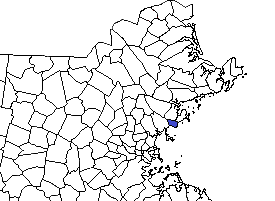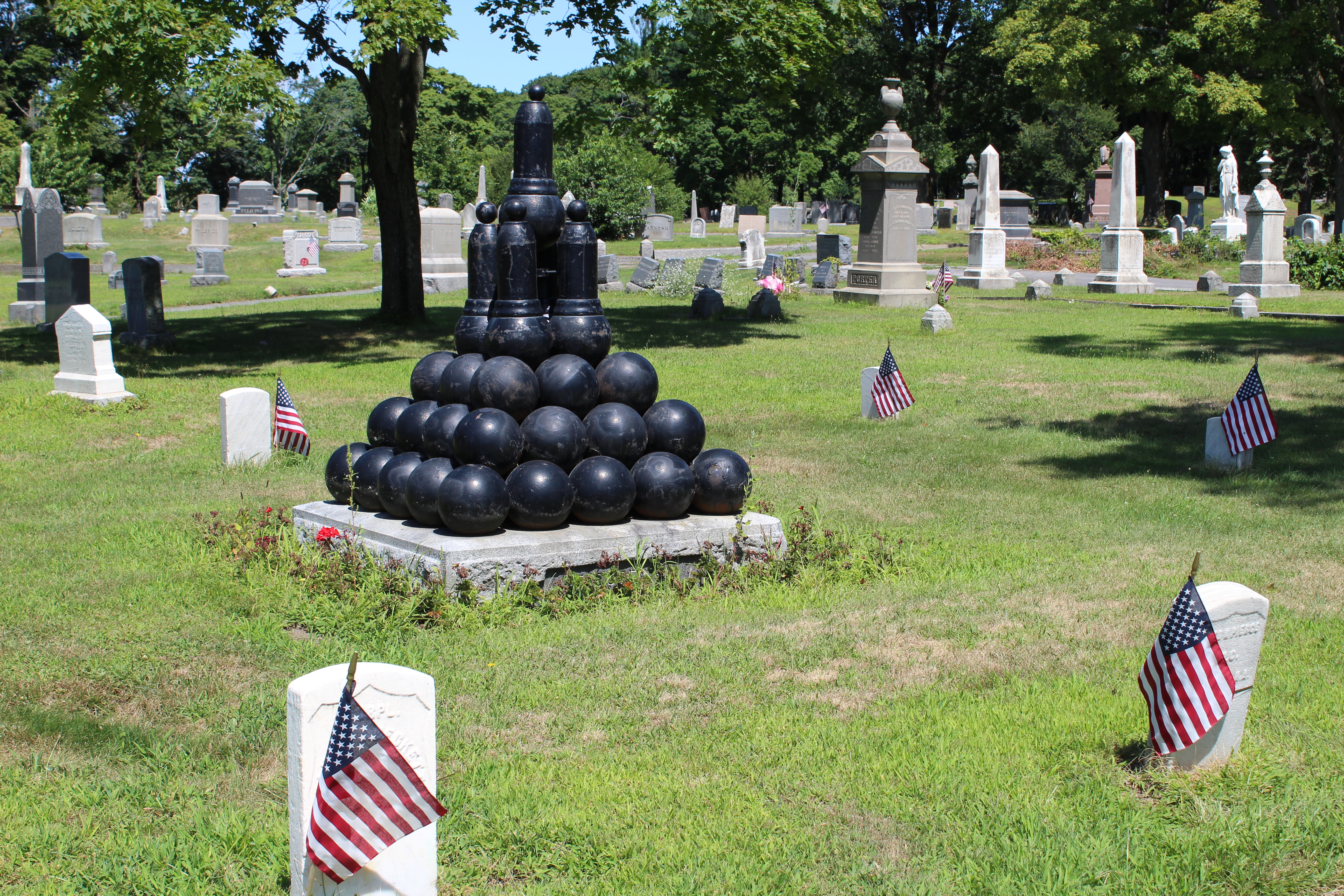
 Location: 1 Monument Avenue, Swampscott
Location: 1 Monument Avenue, Swampscott
Coordinates: 42°28’06.6″N 70°55’04.7″W
Date dedicated: June 16, 1883
Architect/sculptor/manufacturer: Rodney F. Carter, Ryegate Granite Works
Number of names: 14 who died in the war
Located at the center of Monument Square on Nahant Bay, Swampscott’s monument was dedicated on June 16, 1883. Monument Square used to be known as Mudge Square–the land on which the monument stands was donated by the Mudge family in honor of the men from Swampscott who died in the war. The monument was constructed by the Ryegate Granite Works of Vermont, owned by Rodney F. Carter, who built numerous soldiers’ monuments including some on the Gettysburg Battlefield.
The first name on the monument is Lt. Col. Charles R. Mudge. His actions at Gettysburg have made him well-known to those who have studied that battle. He was buried in Lynn, Massachusetts, and therefore his story was briefly told on that monument’s page. However, as Lt. Col. Mudge’s ancestry is so strongly tied to Swampcott, and he lived here for much of his life, it seems fitting to here recount his story in a bit more detail.

Swampscott sent 209 men into service during the Civil War.[1] The largest group of them, 33 men, served with the 45th Massachusetts in minor campaigns in North Carolina.[2] Eight Swampscott men, including Charles R. Mudge, enlisted with the 2nd Massachusetts which became part of the Army of the Potomac and fought in some of the bloodiest engagements of the war.
Mudge graduated Harvard College in 1860. When the war broke out, he was preparing for a career as a manufacturer but set that aside to recruit a company. Some of these men came from small town of Swampscott but most came from the adjacent and much larger city of Lynn where Mudge set up his recruitment headquarters. Mudge’s recruits formed part of Company F of the 2nd Massachusetts. He took the rank of first lieutenant but very soon was promoted to captain and command of the company. And then rose quickly through the ranks as the 2nd Massachusetts fought in battle after battle.
In 1862, the regiment was heavily engaged at the Battle of Cedar Mountain where they suffered 35% casualites. Capt. Mudge was wounded during this fight. Their well-known advance through the infamous Cornfield during the Battle of Antietam is depicted at the beginning of the film “Glory.” When units on either side of them fell back, the 2nd Massachusetts took heavy casualties, including the loss of their second-in-command, Lt. Col. Wilder Dwight. When their colonel resigned after the Battle of Chancellorsville, Mudge stepped in to command the regiment.[3] He was popular with the men. According to Thomas W. Higginson, “…There could be no chance of a word of harshness or of sarcasm from him…Each comrade felt that Mudge saw the bright side of his character, and recognized all his best qualities.”[4]
By the time they reached the Battle of Gettysburg on July 2, 1863, the 2nd Massachusetts was a hardened, veteran unit. Arriving at the battlefield, they were posted in the morning of July 2 in McAllister’s Woods, next to Spangler’s Spring, just south of Culp’s Hill. They took up a defensive position and were told to dig in and build breastworks. At that time, their brigade formed the extreme right of the Union line.
Over the course of that afternoon and evening, as things were going badly on the Union left, General Meade pulled most of the XII Corps off of the right flank and ordered them towards the Roundtops as reinforcements. Leaving their breastworks, the 2nd Massachusetts marched with their division about three miles as the sun set on July 2. By the time they reached the vicinity of the Wheatfield, it was dark and the fighting had essentially ceased there. Eventually, they returned, three more miles, to their former position.
While they were gone the Union right on Culp’s Hill had been hit hard, but held. However, the breastworks where the 2nd Massachusetts had been were now occupied by Confederates. This was not known to the 2nd Massachusetts as they approached the position in the dark. Their skirmishers, more or less blundering into the Virginians, managed to take some prisoner. But there was no hope of re-taking their breastworks at that time, so the regiment pulled back.[5]
The next day, July 3, General Thomas Ruger, their division commander, ordered Colonel Silas Colgrove to retake the rifle pits that had been lost the previous day. There was some confusion about the order, whether Ruger intended for Colgrove to first probe the position with two regiments as skirmishers and determine if an advance was possible. Colgrove took the order to mean that he must immediately storm the position with just two regiments. For this impossible task, Colgrove chose the 27th Indiana and the 2nd Massachusetts.

When Lt. Col. Mudge, received the order, he could not believe his superior would order a frontal assault over open ground against an entrenched position. He calmly asked the orderly to repeat the order. Then Mudge replied, “Well, it is murder, but it’s the order.”[6]
Mudge immediately gave the order, “Up men, over the breastworks! Forward at the double quick!” The order came so quickly that the men did not have time to fix bayonets.[7] The 2nd Massachusetts surged forward into the open and marshy ground around Spangler’s Spring, closely followed by the 27th Indiana.
Early in the charge, Lt. Col. Mudge was shot just below the throat and died almost instantly. Five color bearers of the 2nd Massachusetts were also cut down. In words that sound strange to the modern ear, Major Charles Morse later wrote of the charge, “I never saw men behave so splendidly. It was awful, yet grand.” The 2nd Massachusetts had 22 killed and almost 100 wounded in the charge.
Mudge was initially buried in Pine Grove cemetery in Lynn but later moved to the St. Stephen’s Church in Lynn which Mudge’s father built in memory of his son.
Click to enlarge photos:
[1] Waldo Thompson, Swampscott : historical sketches of the town, (Lynn: Press of T. P. Nichols, 1885), 152.
[2] Massachusetts Soldiers, Sailors and Marines in the Civil War (Boston: Massachusetts Adjutant General’s Office, 1931).
[3] Alonzo Hall Quint, The Record of the Second Massachusetts Infantry, 1861-65, (Boston: J. P. Walker, 1867)
[4] Thomas Wentworth Higginson, Harvard Memorial Biographies, vol. II, (1867), 143.
[5] Stephen W. Sears, Gettysburg, (2003), 331.
[6] Bradley M. Gottfried, Brigades of Gettysburg, (2002), 368.
[7] Sears, 366.



